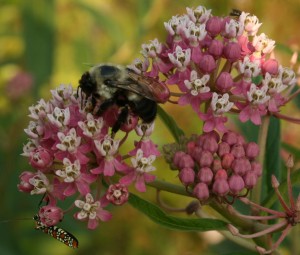Swamp Milkweed – July 2017 Wildflower of the Month
 Swamp Milkweed (Asclepis incarnata) is one of the best plants for monarch butterflies – the nectar feeds the adults and the larvae (caterpillars) eat the leaves. The deep pink flowers growing in wide clusters are attractive also to pollinating bees, wasps, and other butterflies. Long, narrow leaves are paired on thick, 4-foot stems. This species follows Common Milkweed (A. syriaca) that blooms a little earlier and has wide leaves with pale pink to greenish white flowers.
Swamp Milkweed (Asclepis incarnata) is one of the best plants for monarch butterflies – the nectar feeds the adults and the larvae (caterpillars) eat the leaves. The deep pink flowers growing in wide clusters are attractive also to pollinating bees, wasps, and other butterflies. Long, narrow leaves are paired on thick, 4-foot stems. This species follows Common Milkweed (A. syriaca) that blooms a little earlier and has wide leaves with pale pink to greenish white flowers.
Typical of milkweeds, the tiny flowers have 5 petals curving downward and a complex central crown. The unusual structure of milkweed flowers can trap small insects. The pollen is held in two connected sacs (pollinia) that easily attach to the legs of a visiting insect. When the insect visits another flower, the pollinia are deposited into a groove in the stigma where the pollen grain germinates and grows pollen tubes through the stigma to the ovules in the ovary. Small insects such as honeybees can perish in the milkweed flower if their legs get stuck in the stigma’s slit.
While milkweeds are valuable food sources for many insects, the plants have three defenses against caterpillars: (1) the leaves are hairy and distasteful (2) latex fluids in the stems and leaf veins are sticky and (3) the leaves contain toxins which the larvae and adults store in exoskeletons and wings. Predators learn to avoid Monarchs and other orange and black insects since they taste bad, or make them vomit.
Swamp Milkweed prefers moist open areas and is typically found growing wild near the edges of ponds, lakes, open ditches and low areas. The plant is found in every county in Virginia, growing easily in full sun and moist soil in local gardens.
After a long blooming period, from June through August, upright thin pods are produced which split open in the fall, releasing seeds attached to silky hairs that act as parachutes to carry the seeds on the currents of the wind. During World War II milkweed floss was used in life jackets and flying suits; it is warmer than wool and 6 times lighter.
On an expedition to Utah in 1850, a traveler reported that the Pueblo Indians rub the stems to separate the fibers, to make beautiful and very strong fishing lines and fine sewing thread. A decoction was used for various medicinal purposes. Although American colonists used Swamp Milkweed for asthma, rheumatism, worms, and as a heart tonic, the plant is potentially toxic.
By Helen Hamilton, past-president of the John Clayton Chapter, VNPS
Photo: Swamp Milkweed (Asclepis incarnata) taken by Helen Hamilton
